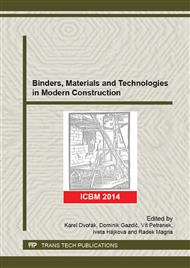[1]
L.F.R. Miranda, S. M. S. Salmo : CDW recycled aggregate renderings: Part I – Analysis of the effect of materials finer than 75 um on mortar properties, Construction and Building Materials, Vol. 20, Issue 9 (2006) pp.615-624.
DOI: 10.1016/j.conbuildmat.2005.02.025
Google Scholar
[2]
V. Corinaldesi, G. Moriconi: Behavior of cementitious mortars containing different kinds of recycled aggregate, Construction and Building Materials, Vol. 23, Issue 1 (2009) pp.289-294.
DOI: 10.1016/j.conbuildmat.2007.12.006
Google Scholar
[3]
M. Draganovska, in: A function of fine particles in the structure of cement composites, Proceedings of scientific papers UEI 2013, Košice : TU, (2013) pp.10-20. - ISBN 978-80-553-1585-0, in Slovak.
Google Scholar
[4]
Y. Senhadji, G. Escadeillas, G. Mouli, et. all: Influence of natural pozzolan, silica fume and limestone fine on strength, acid resistance and micorsturcture of mortars, Powder technology, Vol. 254 (2014), pp.314-323.
DOI: 10.1016/j.powtec.2014.01.046
Google Scholar
[5]
V. Sata, Ch. Jaturapitakkul, K. Kiattikomol: Influence of pozzolan from various by-product materials on mechanical properties of high-strength concrete, Construction&BuildingMaterials, Vol. 21 Issue 7(2007), pp.1589-1598.
DOI: 10.1016/j.conbuildmat.2005.09.011
Google Scholar
[6]
A. Khmiri, B. Samet & M. Chaabouni: Assessement of the waste glass powder pozzolanic activityby different methods, IJRRAS 10 (2012), Information on http: /www. arpapress. com/Volumes/Vol10Issue2/IJRRAS_10_2_18. pdf.
Google Scholar
[7]
L. Turanli, F. Bektas, P.J.M. Monteiro: Use of ground clay brick as a pozzolanic material to reduce the alkali–silica reaction, Cement & Concrete Research, Vol. 33, Issue 10 , pp.1539-1542, in: Academic Search Complete (2003).
DOI: 10.1016/s0008-8846(03)00101-7
Google Scholar
[8]
Y. Shao, T. Lefort, S. Moras, D. Rodriguez: Studies on concrete containing ground waste glass, Vol. 30, Issue 11 (2000), p.91–100, Information on http: /www. sciencedirect. com/science/article/pii/S0008884699002136.
DOI: 10.1016/s0008-8846(99)00213-6
Google Scholar
[9]
M. Kosior- Kazberuk: Application of SSA as partial replacement of aggregate in concrete, Faculty of Civil Engineering, Bialystok University of Technology, Poland (2010).
Google Scholar
[10]
I. B. Topçu, T. Bilir: Experimental investigation of drying shrinkage cracking of composite mortars incorporating crushed tile fine aggregate, Materials & Design, Vol. 31, Issue 9 (2010), pp.4088-4097.
DOI: 10.1016/j.matdes.2010.04.047
Google Scholar
[11]
S. Guettala, B. Mezghiche: Effect of addition the dune sand powder on development of compressive strength and hydration of cement pastes, Engineering and Technology, Vol. 6, (2012).
DOI: 10.1016/j.conbuildmat.2010.09.026
Google Scholar
[12]
M. Draganovska in: Influence of sludge as a partial substitution of fine aggregate for long-term compressive strength of concrete, Young Scientist 2014: 6th PhD. Student Conference of Civil Engineering and Architecture, (2014).
Google Scholar
[13]
M. Draganovska, A. Sicakova: Verification of specific grinding parameters and strength activity index of glass and clay brick (C&DW), Pollack Periodica, Vol. 10, Issue 1 (2015), in press.
DOI: 10.1556/606.2015.10.3.16
Google Scholar
[14]
EN 450-1: Fly ash for concrete. Part 1: Definition, specifications and conformity criteria, (2013).
Google Scholar
[15]
EN 1015-3: Methods of test for mortar for masonry. Part 3: Determination of consistence of fresh mortar (by flow table), (2000).
DOI: 10.3403/01541440
Google Scholar
[16]
EN 1015-11: Methods of test for mortar for masonry. Part 11: Determination of flexural and compressive strength of hardened mortar, (2001).
DOI: 10.3403/01905442
Google Scholar
[17]
EN 13670: Execution of concrete structures. (2010).
Google Scholar
[18]
EN 1015-12, Methods of test of mortar for masonry. Part 12: Determination of adhesive strength of hardened rendering and plastering mortars on substrates, (2001).
DOI: 10.3403/02027531u
Google Scholar
[19]
O'Farrell, S. Wild, and B. B. Sabir in: Sorptivity and Water Absorption of Mortars Incorporating Waste Clay Brick, International Concrete Abstracts Portal, Vol. 199, 2001, pp.853-868.
DOI: 10.14359/10552
Google Scholar


